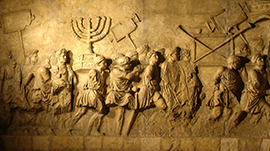In the ancient world, the menorah was the most widely used symbol of Judaism but was initially a sacred vessel in the Israelite period.
At the most basic level, the menorah was a lampstand with seven branches, each of which held aloft an oil lamp. As a ritual object, the menorah dates back to Israelite times where it was one of the most important cultic vessels alongside ark of the covenant, the showbread table, and incense altar. Its golden form and elaborate floral decoration is first described in the lengthy account of the wilderness tabernacle in Exodus (esp.
Following the destruction of the temple by the Romans in 70 C.E., the continued use of the menorah in synagogues is confirmed by accounts in rabbinic literature as well as by archaeological discoveries. Several freestanding menorahs in synagogues from the land of Israel date from the 3rd century C.E. or later. Depictions of the menorah in many mosaics and frescoes from late antiquity (3rd-5th centuries C.E.) suggest that the menorah had a prominent place in the synagogue, as in the tabernacle and temple before.
On a functional level, the menorah provided light for the ritual and liturgical activities. Ancient authors most commonly explained the cultic significance of the menorah in terms of the light it provided. The prophet Zechariah offered a Persian period (6th-4th century B.C.E.) interpretation of the menorah as “the eyes of the Lord” (
Prior to the late-Roman period (3rd-4th centuries C.E.) and while the temple still stood, the menorah only appeared occasionally as a symbol or motif. Early occurrences include depictions on Hasmonean coins, on clay lamps, and in burials on ossuaries and as graffiti. In this early period however, the menorah does not seem to have been used with any special prevalence as a symbol or marker of Jewish identity; other motifs and ritual objects, such as the facade of the temple or the showbread table, appear at least as often.
In the third century C.E., the menorah’s popularity dramatically overtakes other motifs in Jewish art and iconography in an astonishingly wide variety of contexts. Depictions of menorahs are found on objects used from daily life such as bread stamps and lamps, and on ritual objects like incense shovels. We see menorahs in synagogues in architectural reliefs (as at Magdala), on mosaic floors, and in Jewish burials, where menorahs were painted, carved or incised on walls and tomb seals, on grave goods and sarcophagi.
The popularity of the menorah is best explained as the result of several factors. First, the menorah was a prominent sacred vessel in both the temple cult and in ancient synagogues. Used symbollicaly, it provided a link to central Jewish institutions. Furthermore, the menorah was easily the most distinct and recognizably “Jewish” object in antiquity. The Jewish god was imageless, and other ritual objects like offering tables and incense shovels were similar or the same as those used in pagan cults. The menorah had the advantage of being simple in form, easy to depict, and unique to the Jewish religion.
Another possible factor was the influence of Christianity. There is little doubt that the growth of Christianity and the proliferation of the cross as a symbol of Christian identity played a role in elevating the menorah as a visual Jewish symbol. Like the menorah, the cross was used symbolically in a wide range of private and public contexts to mark objects, individuals and spaces as Christian. It is important to point out however, that use of the menorah as a Jewish symbol predated the Christianization of the Roman empire by at least a century.
Bibliography
- Fine, Steven. “‘The Lamps of Israel’: The Menorah as a Jewish Symbol,” in Art and Judaism in the Greco-Roman World: Toward a New Jewish Archaeology (New York, 2005), 146-63.
- Hachlili, Rachel. The Menorah, the Ancient Seven-Armed Candelabrum: Origin, Form, and Significance. Leiden: Brill, 2001.
- Levine, Lee I. Visual Judaism in Late Antiquity: Historical Contexts of Jewish Art. New Haven: Yale, 2012.





